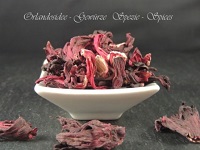
Hibiscus
Dried petals with a bright, pleasantly sour taste
Dried hibiscus lends a vivid ruby color and refreshing, gently tart flavor. Most culinary hibiscus comes from Hibiscus sabdariffa (roselle) and is ideal for teas, cordials and light, aromatic cooking.
- Botany: Hibiscus sabdariffa (roselle) • Family: Malvaceae
- Part used: calyces/petals, dried (whole or cut)
- Profile: fruity-tart, cranberry-like; vibrant color
- Best for: teas & tisanes, syrups/cordials, salads, desserts, light fish dishes
Brewing & Cordial
- Tea: 1–2 tsp (≈1–2 g) dried hibiscus per 250 ml water at ~95 °C; steep 5–7 min; strain.
- Cordial/syrup base: 5–10 g per 500 ml water; simmer 5 min, steep off-heat 10–15 min, strain; sweeten 1:1 with sugar to make syrup.
Culinary uses
- Salads: finely crumble and sprinkle for color and gentle tartness.
- Fish: reduce a hibiscus syrup to glaze poached white fish; add a squeeze of citrus.
- Desserts: infuse creams or syrups for panna cotta, ice cream, sorbets or poached fruit; strain for a smooth finish.
How to use
- Infuse & strain: for clear flavor in liquids; petals can be strong if left in.
- Add late/off-heat: preserves bright color and fresh tartness.
- Balance: soften acidity with sugar/honey or fat (cream, yogurt) and a touch of salt.
Dosage & kitchen ratios
- Teas: 1–2 tsp per 250 ml water.
- Syrups: 5–10 g per 500 ml water before sweetening.
- Dairy infusions: 1–2 tsp per 250 ml warm milk/cream; steep 10 min; strain.
Pairings
Citrus (orange, lime), ginger, mint, vanilla, cinnamon; berries, tropical fruit, yogurt and light white fish.
Ingredients & allergens
Ingredients: dried hibiscus petals/calyces (100%).
Allergens: none mandatory in EN labeling for this single ingredient.
Storage
Store airtight, cool, dry and away from light. Best aroma and color within 12–18 months. Reseal promptly after use.
Wholesalers: info@orlandosidee.de



